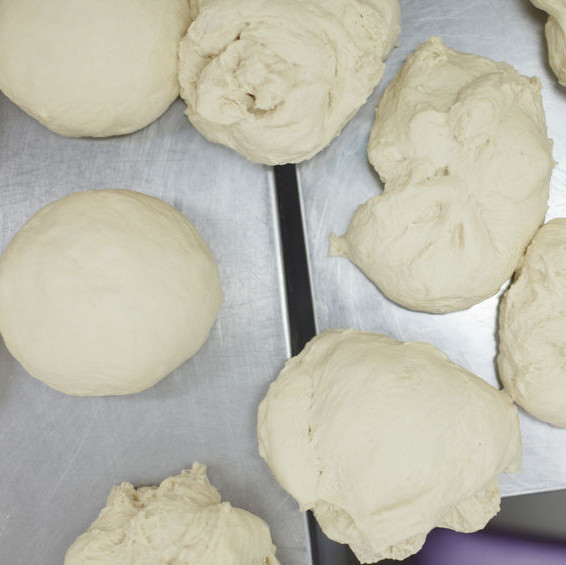
Dough Handling Properties
What are Dough Handling Properties?
One of the goals of the mixing process in breadmaking is to achieve an optimum and proper balance of dough handling properties. There are 4 major dough handling properties:1
- Extensibility
- Elasticity
- Resistance to deformation (tenacity)
- Stickiness
At the bakery, frequent complaints such as “the dough is too tough” or “the dough has too much pan flow” or “let’s decrease water, the dough is too sticky” are often discussed. Bakers always aim to produce the best dough possible for the makeup stage. A big portion of the credit for baking a high-quality bread goes to the handling properties of dough.
How does it work?
It is important to understand what the handling properties of dough mean, how they are affected and how they affect the finished products.
- Extensibility: Ability of the dough to be stretched, extended or elongated when forces, stress and pressures are applied to it. A certain amount of extensibility is necessary for a dough to be moulded into different shapes. An extensible dough has the ability to stretch (expand) as the gas pressure from yeast fermentation builds up.
- Elasticity: Ability of the dough to regain its original shape after a deforming force has been applied and removed. Simply put, it is the ability of a dough to spring back when it is stretched.
- Resistance to deformation (tenacity): Ability of the dough to resist deformation when being stretched. A dough with too much tenacity is difficult to work with during makeup. Laminated doughs that are too tenacious are often difficult to roll out.
- Stickiness: Ability of the dough to stick to the surfaces which they come into contact with. Dough needs to have minimum stickiness to be properly shaped and conveyed during makeup stages. In most cases, dough stickiness is the least desired property given the operational and cleaning issues that a bakery has to deal with. The simplest way of modifying the stickiness of dough is by increasing or decreasing water absorption.
Application
First, it is important to note that a bread dough is not a simple material. The four handling properties of a dough piece respond proportionally to its non-Newtonian behavior.
It is the presence of gluten-forming proteins which allows wheat doughs to exhibit a viscoelastic behavior with fluid-like (viscous) and solid-like (elastic) components.2
Optimizing dough properties
In general, a dough should have good extensibility and just enough elasticity to retain gasses yet expand sufficiently during proofing and baking (oven spring) while retaining its original or desired form.3
Similarly, a dough should have as little resistance to deformation as possible to allow for a proper moulding while preserving the “delicate” cell structure.
The balance between elasticity and extensibility may of course change depending on the product and dough needed. For example, hearth breads require good extensibility and good elasticity otherwise the loaves could flatten out rather than bake up high and round.
Aspects that influence dough handling properties
- Wheat class used at the mill (% extraction)
- Hydration (water absorption)
- Percentage of functional polymers (i.e. arabinoxylans, gluten-forming proteins, damaged starch)
- Quality of gluten-forming proteins (gliadins and glutenins)
- Presence of bran particles (exerting a cutting or disrupting action on the gluten matrix)
- Presence of some non-wheat cereal flours
- Mixing conditions (rpm, work input, mix time)
- Overmixing/undermixing
- Degree gluten development
- Dough temperature
- Presence of water-competing ingredients (e.g. sugars, salt, egg proteins) that limit the hydration of functional polymers
- Addition of functional ingredients, such as oxidizing and reducing agents
- Length of dough resting period
Characteristics of a dough that is too extensible, with very low elasticity and poor resistance to deformation:
| Processing | Finished product |
|
|
If a dough is too elastic, with very low extensibility and too much resistance to deformation, it will exhibit the following characteristics during processing:
- Dough mixing: possible undermixing (dough too stiff, tight and/or tough), insufficient water absorption.
- Dough pump: excessive friction against equipment surfaces causes excessive heat which increases dough temperature beyond allowable limits (promoting excessive gas production).
- Dough divider: bucky or gassy dough could cause considerable scaling weight variations.
- Dough sheeting and moulding: poor machining as moulder and sheeter settings (pressures) must be increased (tightened) to form the final dough shape leading to cell structure damage, excessive ‘spring-back’ after application of stress, poor pan flow.
As a result, the finished product will have too round of corners, wild break and shred, and poor symmetry, volume and diameter (in the case of pizza crusts).
References
- Cauvain, S.P. “Breadmaking Processes.” Technology of Breadmaking, 3rd edition, Springer International Publishing, 2015, pp. 23–50.
- Steffe, J.F. “Introduction to Rheology.” Rheological Methods in Food Process Engineering, 2nd edition, Freeman Press, 1996, pp. 11–93.
- Cauvain, S.P. “Principles of Dough Formation.” Technology of Breadmaking, 3rd edition, Springer International Publishing, 2015, pp. 303–334.

